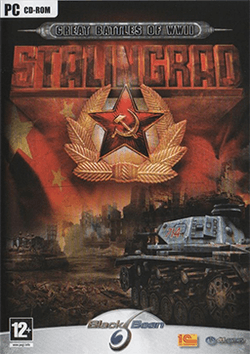Stalingrad (2005 video game)
| Stalingrad | |
|---|---|
 Cover art | |
| Developer(s) | DTF Games |
| Publisher(s) | BlackBean Games, 1C Games |
| Designer(s) |
Alexander Fedorov Petr Prohorenko Maxim Maslov Evgeny Lazutkin Vasily Stepanenko et al. |
| Composer(s) | Skafandr |
| Engine | Enigma engine |
| Platform(s) | Windows |
| Release date(s) |
|
| Genre(s) | Real-time tactics |
| Mode(s) | Single player only |
Stalingrad (also known as Great Battles of WWII: Stalingrad) is a stand-alone real-time tactics game for the PC developed by Russian company DTF Games. The game is built-up upon Nival Interactive's Enigma engine that was used in the Blitzkrieg game and is a fully stand-alone product.
Campaign structure and maps
Stalingrad features two campaigns based around the events in southern Russia between summer 1942 and early 1943. The Wehrmacht campaign has the player commanding the 6th Army as it approached the city and the battles for the city itself. The RKKA (Workers' and Peasants' Red Army) campaign follows the Red Army's progress as it liberated Stalingrad and destroyed the 6th Army. In total there are 36 missions, including 7 "bonus" missions that are unlocked if the player fulfills certain objectives in preceding maps. The maps themselves are reproduced from historical tactical maps and actual aerial photography taken during the period that the campaign covers.
Units
The game sports over 150 units (including armoured fighting vehicles, other vehicles and infantry), few of which were carried over from the original game. Notable amongst the new units are the Soviet 203mm B4 heavy howitzer, variants of the Marder self-propelled guns (of which there were few in the original game) and the experimental 12.8 cm Panzerselbstfahrlafette V "Sturer Emil" self-propelled gun. Alongside the mechanical and human units there is also a large number of new buildings and other objects created specifically for the game. These include representations of the grain elevator and the Red October tractor factory.
Gameplay
As it is based on the Blitzkrieg engine then gameplay is similar, though Stalingrad does feature less accurate artillery fire and increased visual and firing ranges (around twice Blitzkrieg's standard). Gone is the concept of core units that the player can keep as he progresses through the campaigns. Instead, Stalingrad simulates unit combat experience with depleted squads and veteran units in the later maps of the campaigns.
Summary
Attention to detail, not just in the game itself, is apparent, with the inclusion of a booklet inside the presentation box and an interactive encyclopedia (hidden away in the installation folder and accessible via the EXTRA.exe application). A completely revamped interface makes Stalingrad differ to its Blitzkrieg siblings.
The game is well-known in the Blitzkrieg community, not just for its merits as a game that strives for historical accuracy, but for its fix to the "line of fire" bug (and other minor bugs) that were present in the original engine. This bug, which allowed units to engage other units through static objects such as buildings, can thankfully be corrected by replacing one file in the Blitzkrieg installation with an updated file of the same name from Stalingrad. The lack of a map editor or menu options to access custom missions was easily overcome by the Blitzkrieg community with several custom made maps appearing for the game as well as several modifications.
In Russia and the CIS the game was released by 1C Games. In most of Europe Stalingrad was distributed by BlackBean Games (from March 2005) under the title Great Battles of WWII: Stalingrad and CDV (in Germany only). The 1C and BlackBean releases included swastika emblems which were removed from the German release in order to comply with German federal laws. There was no official release in the United States.
Reception
It holds an average score of 73% and 60.00% at GameSpot and GameRankings.[1][2]
References
- ↑ "Stalingrad". GameSpot. Retrieved February 1, 2016.
- ↑ "Stalingrad for PC". GameRankings. March 25, 2015. Retrieved February 1, 2016.
External links
All external links broken
| ||||||